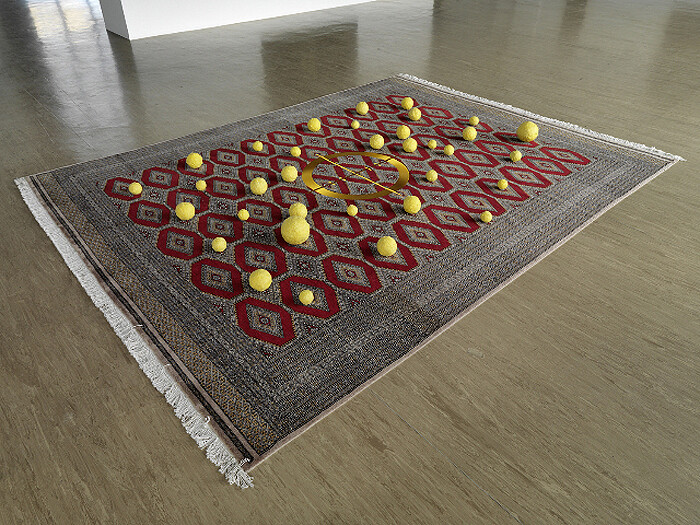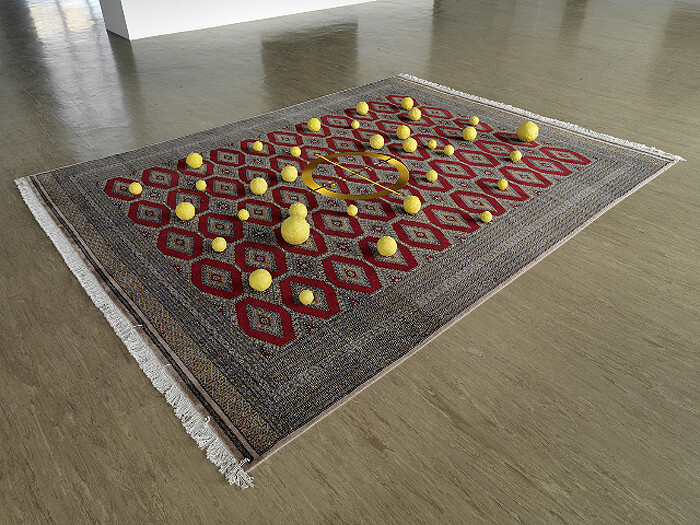The title of Rashid Johnson’s first solo show in Berlin makes a sideways allusion to “Stranger in the Village,” an essay written in 1955 by American writer and civil rights activist James Baldwin. This is worth bearing in mind; not because the situation in Berlin mirrors that of the remote Swiss village in which Baldwin found himself as the first black man the astonished villagers had ever seen—as Johnson says, “there are stranger villages”—but nevertheless, the African-American experience of racism, inseparable as it is from the ugly legacy of slavery, hatred, and exploitation, has a different timbre to that in Europe. “I am a stranger here,” said Baldwin, “but I am not a stranger in America.”
Johnson’s works take up the question of African-American identity and present its symptoms in object form. Despite their local production—Johnson spent the summer living in Berlin to produce the exhibition—the works here revisit several of the artist’s now signature forms and themes. Large black wall-mounted panels with perpendicular shelves supporting various objects such as house plants, books, record covers or small bronze sculptures; black-and-white portrait photographs with a nineteenth-century feel; small paintings with dense black and white cosmologies arrived at by covering the canvas with lentils or grains and spraying it with black paint. Also in evidence are the very specific materials—black soap, bright yellow shea butter (here either in little votive bowls on shelves, in snowball forms arranged in orderly lines on a carpet, or as a monumental gaudy block on a black plinth)—which Johnson has adopted as his own, like Beuys’s wax or Barney’s Vaseline.
There are eight of Johnson’s altar-like wall units: six in black and two in white. With either smooth tiled surfaces, or else daubed with black soap and dripping with wax and adorned with gold-sprayed tag lines, they support strategically arranged collections of material whose calculated codes of reference locate the artist’s identity in terms of skincare, interior design and 1970s domestic experience, as much as music, literature or cultural history. The record sleeves (Isaac Hayes, Lloyd Price) and books (James Baldwin, Muhammad Ali) are like windows into a cultural history. But just as the shea butter and black soap propose the black skin as a surface to be treated and conditioned, so these books and records, which cannot be read or listened to, become symbolic touchstones that have more to do with cover image and title, than with content. More concerned with conspicuous symmetry and color coordination than polemics, the works wear their allusions lightly, pointing in the direction of serious debate, but keeping it at arm’s length. The repetition of the wall panel as a form seems to dilute rather than accrue conceptual meaning, however; their components, which can be apparently arranged endlessly, seem ultimately arbitrary.
A new portrait (Marcus, 2010), adding to the serial photographic work “The New Negro Escapist Social and Athletic Club,” fares better. Here, the serial nature of this ever-growing group of imaginary, nineteenth-century black intellectual dandies implies an increasing membership that makes sense for the work’s concept. In Black Yoga (2010), meanwhile, a modest video work displayed on an oriental carpet which itself appears in the film (spread on a grassy lawn in a tree-lined park) a black man performs a series of highly gestural yoga moves, with a touch of Thai Chi and modern dance thrown in. The humorous tone of this esoteric-exotic redux suggests a more fluid appropriation of outdated symbols than the ponderous wall panels achieve, although their punning titles (Keep Souls Handy, 2010, a play on W.E.B. Du Bois’s The Souls of Black Folk, for instance) suggest this is also what they are aiming for. “People are trapped in history and history is trapped in them,” wrote Baldwin in his essay. By treating the touchstones of history with levity, Johnson seems to be trying to find a way out of this cultural straitjacket, but a more flexible approach to form may be needed for the escape attempt to succeed.






